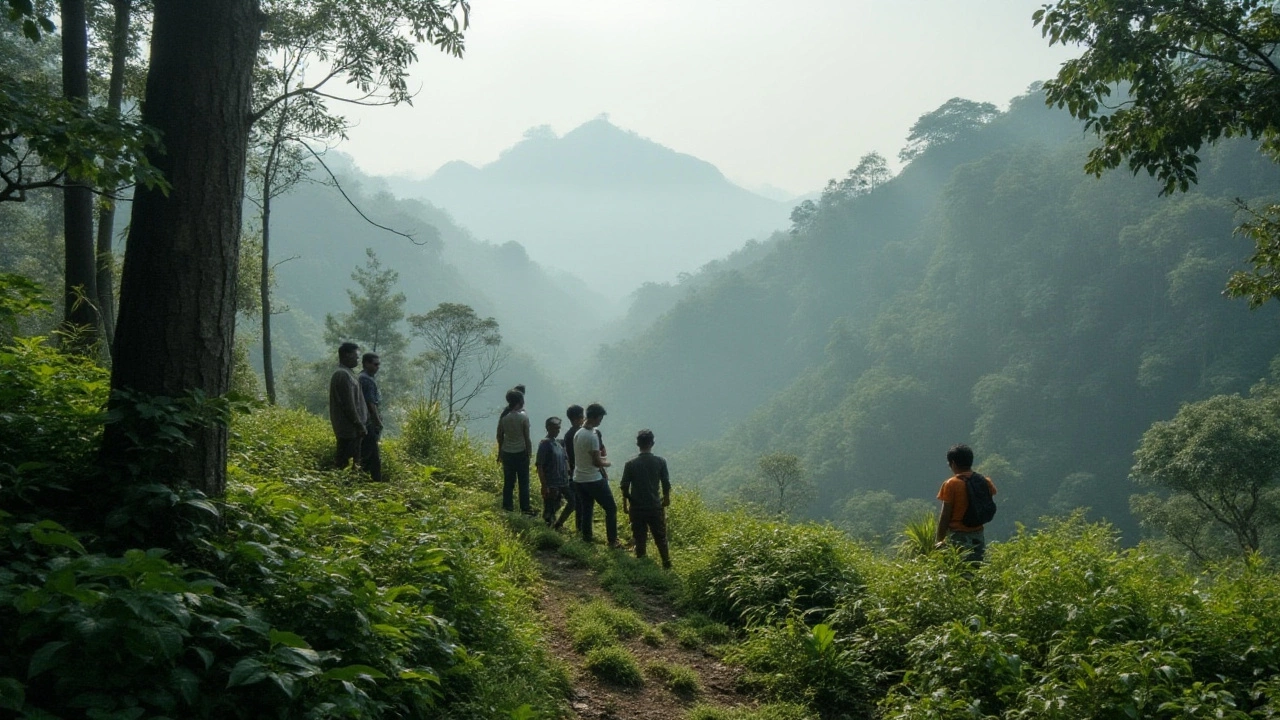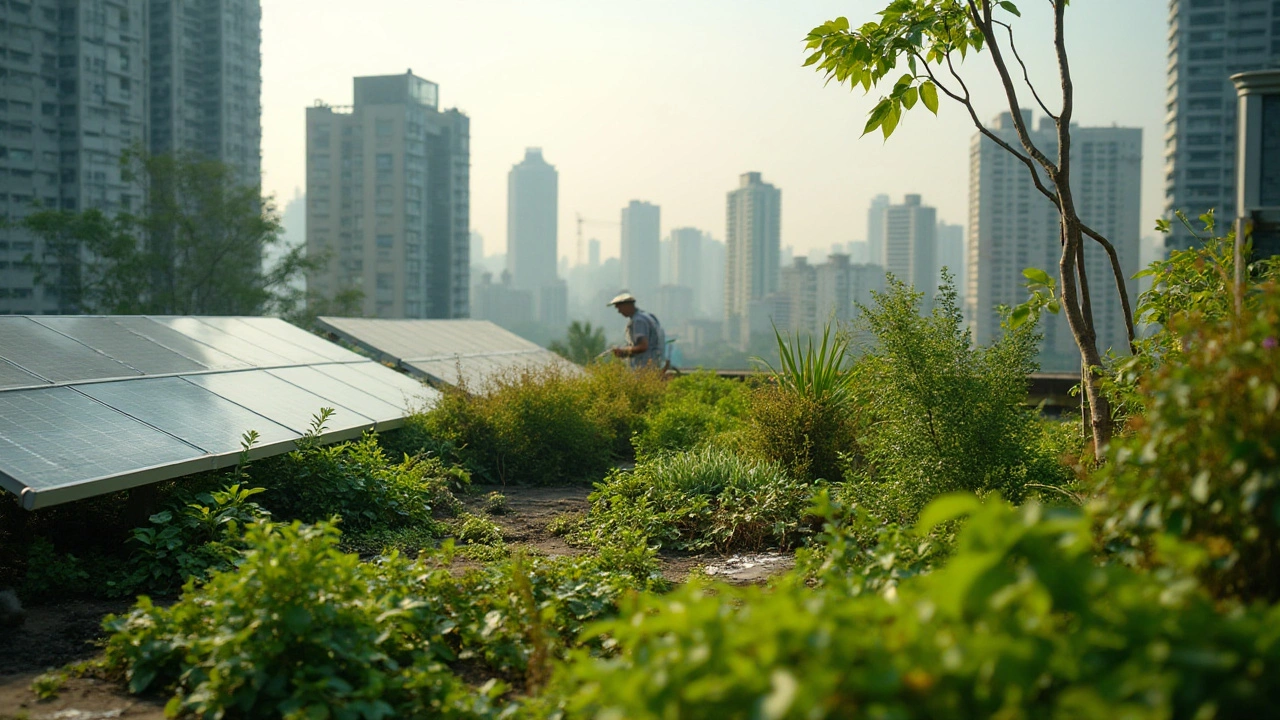Exploring Key Research Questions in Climate Change
 Jan, 22 2025
Jan, 22 2025
Climate change, a pressing challenge of our era, commands attention and action from every corner of the globe. Whether it's the heatwaves sweeping across continents, the unpredictable rainfall patterns, or the continual rise in sea levels, the scientific community works tirelessly to unravel the complexities of this phenomenon. Key research questions in climate change aim to dissect its multifaceted impacts, offering insights into how our planet and societies respond.
In the quest to understand these impacts and formulate effective solutions, researchers pose critical questions about the relationship between climate change and ecosystems, the effectiveness of our mitigation strategies, and the socio-economic implications. Each of these inquiries plays a vital role in crafting policies that foster a sustainable and resilient future. Stay tuned as we delve into these pivotal questions and explore the reasons they are at the forefront of climate research.
- The Impact of Climate Change on Ecosystems
- Effectiveness of Mitigation Strategies
- Socio-economic Consequences of Climate Shifts
- Evaluating Emerging Climate Solutions
The Impact of Climate Change on Ecosystems
Climate change is not just a scientific concept; it is a reality that is profoundly altering the natural ecosystems on which life on Earth depends. As global temperatures rise, ecosystems across the globe are undergoing dramatic transformations. The Arctic, for instance, is warming at twice the rate of the rest of the world, causing ice to melt and sea levels to rise. This has severe implications for species such as polar bears and seals, which rely on the ice for their habitat and hunting grounds. The ripple effect of these changes can be felt down the food chain, disrupting entire ecological systems.
In tropical regions, coral reefs, known broadly as the rainforests of the sea, face dire consequences due to ocean acidification and warming waters. Coral bleaching events have become more frequent and severe, threatening the biodiversity that these reefs support. Thousands of marine species depend on coral reefs for sustenance and shelter, and the loss of these reefs could lead to the collapse of marine ecosystems. According to the National Oceanic and Atmospheric Administration (NOAA), nearly 50% of the world's coral reefs have already been destroyed or severely degraded.
Forests, too, are feeling the heat. Increased temperatures and changing precipitation patterns are contributing to more frequent and intense wildfires, particularly in regions like the western United States and Australia. These fires not only decimate vast swathes of forest but also release copious amounts of carbon dioxide, exacerbating climate change. The loss of forests results in reduced biodiversity, as countless species lose their homes, and impacts carbon sequestration significantly, highlighting the intricate connections within ecosystems.
"The effects of climate change and its influence on ecosystems extend beyond the physical environment to include profound impacts on biological diversity."—E.O. Wilson, Biologist
The impact of climate change on ecosystems is not uniform, with some species and areas experiencing more drastic changes than others. For instance, amphibians are among the most vulnerable; their reliance on specific climate conditions for breeding makes them particularly susceptible to shifts in temperature and precipitation. Altered weather patterns can disrupt breeding cycles, leading to population declines or even extinctions. As ecosystems shift, species must adapt, migrate, or face possible extinction, altering the balance of biodiversity.
Human intervention has both exacerbated and attempted to mitigate these impacts. Conservation efforts, such as establishing protected areas and wildlife corridors, aim to support species in the face of a rapidly changing climate. However, these efforts require careful planning and international cooperation. The success of such endeavors relies heavily on our understanding of how climate change affects individual species as well as entire ecosystems. The stakes are high, as ecosystems provide essential services such as pollination, carbon storage, and clean water, which are crucial for human survival.

Effectiveness of Mitigation Strategies
Tackling climate change demands more than just recognition of the problem; it necessitates robust and effective mitigation strategies to curb our environmental impact. These strategies aim to reduce or prevent climate change's root causes, primarily focusing on cutting down greenhouse gas emissions. The role of renewable energy sources, such as wind and solar power, has been pivotal. They not only provide cleaner alternatives but have continuously become more economically viable compared to fossil fuels. With innovations driving costs lower every year, adopting green energy isn't just an environmental choice anymore; it is increasingly a financially sound one too.
Carbon pricing, another critical strategy, puts a financial cost on carbon emissions. By setting a price on carbon, it incentivizes companies to cut emissions, invest in cleaner technologies, and fosters a competitive market for sustainable practices. According to the World Bank, as of 2022, 68 countries have adopted some form of carbon pricing, a significant upturn from a decade ago. Yet, the effectiveness of this approach largely depends on the stringency of the pricing and the political will to maintain its implementation.
The Intergovernmental Panel on Climate Change (IPCC) noted, "Mitigation requires changing how our societies produce energy, eat food, grow crops, and transport goods." This highlights the multifaceted nature of effective strategies.Energy efficiency improvements provide another significant area for mitigation. From smarter building designs to advancements in vehicle technology, energy consumption is being optimized on multiple fronts. These efforts are crucial as they not only reduce emissions but often result in cost savings for consumers, creating a direct incentive for widespread adoption. The focus on sustainable agricultural practices also falls within this strategy; by improving soil health and optimizing water usage, agriculture can both adapt to and mitigate the impacts of climate change.
Yet, despite the progress and technological advancements, challenges remain. Implementing these strategies on a global scale requires synchronization among nations, which can be beleaguered by varying national interests and economic disparities. Developing countries, while perhaps most vulnerable to climate changes, may lack the resources to implement robust mitigation strategies without international support. This dynamic underscores the critical role of international agreements like the Paris Agreement, designed to bring countries together to pledge emission reductions and provide a framework for financial and technical support to developing nations.
In evaluating the effectiveness of these strategies, metrics like emission reduction percentages, cost savings, and renewable energy adoption rates are all telling indicators. For example, the International Energy Agency reported that solar power additions globally reached around 200 gigawatts in 2023, exceeding all other technologies and highlighting a promising trend in energy transition. The collective effort to mitigate climate change's impacts is indeed significant, but the journey is far from over. The climate science community continues to analyze and refine these strategies, seeking to make them more effective and accessible worldwide.

Socio-economic Consequences of Climate Shifts
Many aspects of human life, from agriculture to urban development, find themselves influenced by the changing climate. These changes ripple through social and economic systems in profound ways, demanding an adaptive response from communities worldwide. For instance, coastal cities face relocation dilemmas due to rising sea levels, putting thousands at risk of becoming climate migrants. This, in turn, prompts questions about infrastructure resilience and urban planning. Additionally, the agricultural sector wrestles with shifts in crop yields and pest dynamics as temperatures and precipitation patterns change, potentially threatening food security.
The impact on socio-economic systems can also be observed in sectors like health, where climate change exacerbates issues such as respiratory illnesses and vector-borne diseases. Insurance and finance industries also navigate new waters, adjusting to the realities of climate risk and damage assessments. A report by the Intergovernmental Panel on Climate Change (IPCC) highlights how increased frequency of extreme weather events compounds economic losses globally, estimating costs that could escalate into trillions of dollars over the next few decades. This stark reality has sparked urgent calls for climate-adaptive infrastructure and economic diversification strategies.
Mark Carney, former Governor of the Bank of England, once stated, "Climate change is a tragedy of the horizon. We need to start acting now to fend off the worst economic impacts."
Moreover, there is a significant intersection between climate alterations and migration, with many individuals forced to leave their homes due to environmental degradation. This phenomenon places additional stress on receiving areas, both socially and economically. The migration issue is intertwined with national security concerns as resource scarcity becomes a source of tension between communities and countries. As these climate change issues arise, they illuminate the necessity for international cooperation and strategic planning in policy circles to mitigate social disruptions.
Addressing these socio-economic challenges demands innovative and inclusive approaches to policy-making. Equitable participation in global markets and access to technological advancements can facilitate resilience in vulnerable communities. Emphasis on green jobs, renewable energy, and sustainable economic models are essential pivots for societies aiming to thrive amidst climate adversity. Achieving these goals requires stakeholders, from governments to private entities, to collaborate effectively, ensuring that responses to climate shifts are both inclusive and sustainable.

Evaluating Emerging Climate Solutions
The world is witnessing a burgeoning interest in developing climate solutions that address the alarming effects of climate change. One of the principal areas of focus has been the advancement of renewable energy technologies. Solar panels and wind turbines, hallmarks of sustainable energy, are now more efficient and accessible than ever. They not only help reduce greenhouse gas emissions but also promote energy independence and create jobs. As technology continues to advance, more sophisticated versions are emerging, like floating solar farms and offshore wind farms, promising even greater output and efficiency. However, there remains a need for continued innovation and investment to explore the full potential of these technologies.
"Renewable energy is our pathway to a sustainable future," noted Dr. Lisa Coleman from the International Energy Agency. "The progression we've seen is commendable, yet we must double our commitments to harness its full potential."
Another promising solution in the climate arena is carbon capture and storage (CCS) technology, which seeks to trap carbon dioxide emissions from sources like power plants and store them underground. Though the concept is not new, advancements are refining its feasibility and cost-effectiveness. Some nations, like Norway, are already implementing CCS at a scale that could set a precedent for others to follow. This technology, if successfully scaled, can act as a bridge in our transition from fossil fuels to sustainable alternatives. Yet, challenges such as leakage, high costs, and the energy required for capture need address when implementing these solutions at a larger scale.
The agricultural sector also presents opportunities for innovative climate strategies. Practices such as regenerative farming, which involves no-till farming, crop rotation, and cover cropping, have gained traction for their dual role in producing food while enhancing soil health and sequestering carbon. Additionally, technological advancements like precision agriculture can optimize resource use, reducing emissions and improving sustainability. The interplay between agriculture and climate change continues to be a significant area of research, as it can dramatically influence both carbon emissions and food security.
Sustainable transportation initiatives are gaining momentum as well, with electric vehicles (EVs) leading the charge. Automotive innovations, coupled with supportive policies, have accelerated the sales and use of EVs across the globe. Battery technology has also taken leaps forward, allowing for longer ranges and shorter charging times, making electric vehicles a viable option for more consumers. These developments, combined with investments in public transportation and cycling infrastructure, could significantly reduce pollution levels and promote cleaner urban environments.
Innovative financial instruments are also emerging as enablers of climate solutions. Green bonds, for instance, raise capital for projects that have environmental benefits, making it easier for governments and companies to embark on sustainable initiatives. With major players like the European Union dedicating resources through its European Green Deal, there's an impetus for a global shift in funding priorities. These financial mechanisms not only drive technology and project implementation but also send a powerful signal to the markets about the future of investments.
In examining these emerging solutions, a mix of optimism and realism is crucial. While the innovation in climate change mitigation is commendable, substantial efforts are necessary to address hurdles such as the economic disparity that limits access to these technologies and their adaptation across varied geographies. The interplay between technology, policy, and societal buy-in will determine the pace and success of our journey toward a sustainable world. As we cautiously tread this path, continuous research, transparent progress tracking, and shared global commitments remain our best guides.